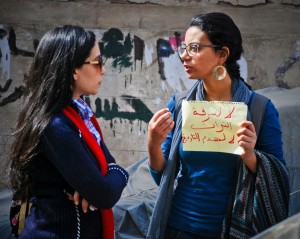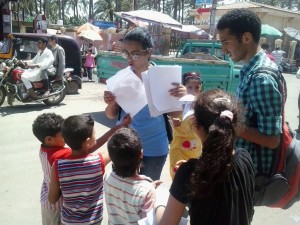Published for Mada Masr
Republished in Jadaliyya
The distant shouts of a female voice rang louder and louder in my ear: “A complete revolution or nothing at all!” I turned around and caught my first glimpse of a young woman of average height, who was outsized by her vocal powers. I was taken aback, impressed, and snapped an image there and then of Mahienour el-Massry — or Mahie, as she is known amongst her circles.
That day was Friday 27 May 2011, in a protest march through Alexandria’s Port Said Street on the Second Friday of Rage. The January 25 Revolution had opened up a world of endless possibilities, and people took to the streets to demand them. Many protests, vigils and revolutionary exhibitions later, I would gradually become more acquainted with a remarkable human being that I have come to consider a friend, inspiration and the conscience of Alexandria.
In a city where you can count the key activists on your fingers, Mahienour (an activist and a lawyer) had immense influence on revolutionary Alexandria. As human rights lawyer Marianne Sedhom remarks, “Mahienour’s loud voice in a small city allowed her to have a greater impact, shape the debate, and inspire many.”
Mahienour, along with seven other activists, is currently serving a two-year sentence for defying the Protest Law, which they were protesting on the day of the retrial of the Khaled Saeed case. Saeed, as you may well know, was killed by the police on June 6, 2010. Public anger against his death by torture initiated the rapid countdown to the 2011 uprising.
Ironically, it was this month four years ago, during the first Khaled Saeed protest, when Mahienour pulled off one of the most daring feats of bravery seen yet. Central security forces at the Cleopatra Hamamat tram station (the site of the protest) were gradually fencing in Mahienour, along with twenty protestors. She was increasingly worried about the safety of protestors arriving from the Corniche and Port Said Street, who were bound to get trapped and arrested.
In a “Run Lola Run” moment, Mahienour took the initiative and ran shouting a slogan in reference to Saeed’s death, and protestors who had arrived late, were lost, or trapped by the security forces, just joined her, running after her through the street, as she called on residents and workers in the area to join in. Many did. As friend Kholoud Said Amer recalls, “We just ran behind her and chanted what she was chanting, and in two minutes, after we were 20, we ended up being a force of 300. The biggest protest until then.”
The security forces were knocked off guard and, rather than arrests, all they could do was prevent the protesters from entering Medhat Seif al-Yazal Khalifa Street — where Saeed had died earlier that month. Mahienour, who was brutalized two years earlier (July 2008) at a police station (as a result of her support for the April 6 Youth Movement’s activities) was clearly on track, and back with a vengeance. She would play a key role in the succession of protest events leading up to the January 25, 2011 Revolution, and beyond.
Be wary of a full moon over Alexandria
Always true to the meaning of her name, moonlight, Mahienour would always be the one to hold a mirror up to society.
The arduous journey of Mahienour since the mid-2000s, when Kefaya came onto the scene, is nothing short of phenomenal, given how a young woman was forced to engage with an Alexandria that conspired to stack the odds against her.
The space for female voices in Alexandria’s public space was scant. This is after all a conservative society and the only alternative to the Mubarak regime was the Islamists, whose influence had virally spread through campuses and neighborhoods. More problematic, many across the social divide were keen on reinforcing a power structure that shunned women.
The city suffered tremendously from a brain drain, a lack of trust among its various political groups, and a civil society that struggles, even until now, to work together. More efforts were usually spent on breaking down barriers of fear and suspicion than anything else. This is in part due to the decades of disembowelment of the public sphere that has reconfigured social formations in the coastal city. But that is the subject of another article.
Cairo activists have faired, I have found, relatively better than their Alexandrian counterparts. Up until 2011 and the changes it brought, there was a near absence of local Alexandrian NGOs and human rights organizations. This means that there were no bodies to mentor, protect and aid Mahienour. For an activist like her, Alexandria was a very lonely place.
Mahienour grew up in an Alexandria that was a laboratory for the application of Egypt’s neoliberal policies since the 1990s — A destructive economic doctrine that widened socio-economic inequalities, and even shrunk the last major bastions of public space in the coastal city: the beaches, which have suffered greatly as a result of such policies. The widening of the Corniche ended up being consumed by a commercialization and privatization frenzy that took up most of the space. In short, the policies applied by the state in Alexandria were hostile to Mahienour’s egalitarian principles.
A friend of Mahienour told me that one of her defining moments was at a young age. She was sitting in the back of her father’s car, when an impoverished women passing by remarked, “I would give my eye for such a car.” The violence of poverty simply crushed her. But she would make it her mission to do something about it.
While Mahienour was a leading figure in the Revolutionary Socialists political group in Egypt, and her views are driven by class conflict, she did not go around trying to blindly impose a Trotskyist textbook approach on the public. Rather, as Alexandrian academic Radwa al-Barouni notes, she places humanitarianism above all political ideologies, with an obsessive drive for social justice and the rule of law being applied fairly and equally to all. She was heavily engaged in local issues and would cover issues that would be seen by other activists as “boring,” such as heritage conservation. Her ability to move confidently through the city’s streets, gather people from all walks of life, and convince them of an issue was one of her many hallmarks.
It always appeared that she did wonders for the Revolutionary Socialists, by making them more approachable and showcasing a third option in a city suffering from an abysmal state-Islamist binary. She seems to have made the group a somewhat acceptable force, but this was mainly because of the unified deep trust that many people had in her.
Belonging to the Revolutionary Socialists and interacting with various Cairene groups made Mahienour better known in international activist circles. Yet, the fact that Mahienour was based outside the capital and wrote mainly in Arabic attracted less international media attention to her.
Humanity unbound
There wasn’t a single struggle that was off limits for Mahienour: human rights, student rights, women’s rights, labor strikes, legal aid, anti-police brutality, housing for the poor, corruption, anti-military trials, heritage preservation, right to the public space, state-led land reclamation from the poor, climate change, street children’s rights, Syrian refugees; the list goes on.
Mahienour was always there, sleeping next to Syrian refugees in police stations to ensure they did not get tortured or deported, advocating for the 21 female supporters of the Brotherhood who were sentenced (and later acquitted) to 11 years in jail, and locating missing persons through the security labyrinth. Mahienour would rush to defend the victim’s rights — regardless of affiliation — and attend the funeral of people she had never met. Her very presence sent a message that this issue really mattered and raised protestors’ morale. Yet she paid a high price.
Mahienour was frequently subjected to scorn, chauvinism, defamation, sexual harassment, beatings, torture, and imprisonment. Yet despite that, as Kholoud remarks, “she would still maintain her humanity.” In person, I always found Mahienour to exhibit no traces of bitterness. She would approach you with a frightening humility, grace, selflessness, and sophistication. In a quiet and comforting tone, she would let you know that she expects the best from you.
Friend and activist Magda Magdy pointed out, “her strength just emanates outwards and seeps through you. We feed on her strength, positivity and deep belief in people, and in the revolution itself.”
Her unmatched stamina and endurance helped her survive the successive waves, not only of state crackdowns, but of activist disintegration. When local activist groups were breaking partnerships as a consequence of increased repression, or more often due to trivial matters, such as a movement’s logo not being placed first on a banner or a stolen idea, Mahienour stuck through the tough and mundane.
Alexandria’s security apparatus has come to fear Mahienour, not least because she never hesitated to publicly name officers, who assaulted her, on television.
Lawyer and friend Salwa Besher mentions that when the military was threatening to evict the residents of East Alexandria’s area of Toson in 2008, Mahienour rushed there, talked to them about their rights, visited them daily, examined legal measures and was their voice in the media. The countless protests, sit-ins, and court cases helped sustain a “war of attrition” that largely staved off the state takeover until the 2011 uprising, after which the court ruled in the residents’ favour.
Finding Alexandria
The linear geography and urban dynamics of Alexandria aided her work, a matter she was well aware of. There are no real posh and secluded neighborhoods (such as the Zamalek island equivalent) in Alexandria, and the notion of gated communities is in its infancy. The public, across classes, are forced to interact. This is reinforced by a transport system that is relatively cheap and moves along three main routes: coastal road, Port Said Street and Abu Qeir street. This is in addition to the web of microbuses, whose hasty drivers weave in and out of the informal settlements on the city’s outskirts. Alexandria’s urban landscape, one could say, lends itself to an overall configuration that enables ideas and movements to rapidly spread through the city. And Mahienour had mastered with efficiency the veins of the city to her advantage.
This grid system helped nurture the rise of protest marches following the uprising of 2011, when there was a mass proliferation of often short-lived Alexandria-based social movements — which even included, bizarrely enough, an Alexandrian secessionist movement. While it often seemed the stage became over-crowded and confused, Mahienour rarely lost her focus on achieving the revolution’s goals: bread, freedom and social justice.
Many Alexandrian activists had eventually gravitated towards Cairo, believing change could only come through engagement with Tahrir Square. Some have migrated to the capital to enhance their activist profile and enjoy the liberal scene, or moved on to a different pathway in life. Mahienour was one of the few key figures who stayed back to hold the fort, committing herself fulltime to activism in Egypt’s second largest, and often forgotten, city. 
In fact, Mahienour was a staunch advocate and spokesperson for decentralization. She always argued for the need to organize parallel fronts in Alexandria to counter the heavy concentration on Cairo and, as Magda notes, she reminded others that Cairo may be the capital and epicenter, but it is Alexandria that is always at the frontline of Egypt’s struggles.
One of her attempts to break away from the centralization was to join up with colleagues to establish a newspaper called “The Second Capital,” to give a voice to Alexandrians, particularly in impoverished neighborhoods, and allow the residents across the city to tell their own stories. She wanted to enable a culture of citizen journalism to thrive and allow Alexandria to, once again, take on a life and vitality of its own. However, hurdles such as funding, time, and, mainly distribution problems resulting from the domination of corporate media, doomed the venture.
And it is possible that one of Mahienour’s main achievements is giving voice to women by inspiring countless numbers to take to the streets to protest for freedom and rights. As Marianne notes, “She was an example to all of us, to find a young woman that we, including men, could follow, whose decisiveness enabled her to take decisions when everyone else was hesitant, and who had no goal except to carry out public welfare, because she truly loves her people.”
Why Mahienour matters
When Mahienour, along with colleagues, was arrested and detained during Mohamed Morsi’s presidency, I realized then how her absence affected the activist community. Mahienour’s presence gave the community much needed focus and cohesion, yet it meant that once she was off the streets and in a jail cell, activists and lawyers would be thrown into a disoriented state. This is the situation today.
Mahienour is, however, a woman that is guilt-ridden and who genuinely believes she is not doing enough. The regime thinks otherwise though; “They fear her enough to send her to prison,” Magda added.
The last time I saw Mahienour, she told me she planned to attend my lecture titled, appropriately enough, “The Agony of Alexandria” (that would take place a week after her trial). But added, “If it [the trial] does not go well, then I ask you to write me at least the main points of your speech.” At that moment, it dawned on me the great loss for Alexandria if Mahienour was to be locked away again.
I stopped myself from telling her that I feared that rather than writing the speech’s main points, I would be writing an article on her imprisonment. It was difficult enough losing our friend Sherif Farag (Alexandrian activist and lecturer at the faculty of fine arts, unjustly imprisoned since last November). But the cautious optimist in me tampered it down to, “everyone will be praying that you make it through any ordeal and that you are with us in the front row.”
Knowing Mahienour, she would rather see exposure redirected towards the forgotten detainees languishing in prison rather than towards her. However, the reason why Mahienour matters is because all detainees matter. Mahienour has grown to be more than just an activist, but an ideal, the embodiment of the struggle, the moral compass of Alexandrian society, the voice of the other Egypt we don’t see, and the signpost of a better Egyptian future.
By illuminating Mahienour’s struggle against injustice, we are making the case for those less known and forgotten detainees.
“A complete revolution or nothing at all” was Mahienour’s ultimate cry. Her call for a complete revolution may not necessarily take on the form of storming the Bastille, but, even more powerful perhaps, it takes the form of an indomitable spirit like Mahienour, who brings hope to the streets she walks, sways the hearts and minds she encounters, and leaves a trail of forgiveness, empathy and humanity in a society that lacks it.
The regime, ever so predictable, has sought to stifle the voice and incarcerate one of the chief visionaries of Alexandria’s streets and its modern agora. However, what is unpredictable is the widespread reaction in seeking freedom for a young woman who has done too much good for many, to just accept the unjust status quo.









